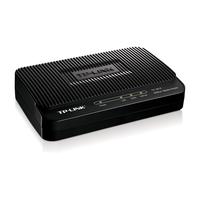TP-Link TD-8816 ADSL2+ Modem and TD-8840T ADSL2+ Modem (with Router)
![]()
![]()
![]()
![]()
![]()
![]()
![]()
![]()

These things may be the nicest DSL modems in the known universe. Paradoxically, they’re also among the least expensive. Plug one in, connect it to the Internet and within five minutes you’ll have entirely forgotten that it exists. One can ask for little more from a telecommunication device.
As nearly as we’ve been able to tell, the TP-Link TD-8816 DSL modem and the TP-Link TD-8840T DSL modem with router are technically identical, save that the former provides a single RJ45 Ethernet connector to communicate with your computer, and the latter provides four. The built-in router in the TD-8840T to drive the four Ethernet connectors allows it to interface to additional devices without the use of an external Ethernet switch.
Aside from just working flawlessly, our TP-Link DSL modems proved to feature lucid documentation, an extensive and easily-navigable web-based user interface and advanced functionality that actually worked. Even in firing up their more complex attributes, they could only have been easier to configure if they’d included on-board clairvoyance, which would have unquestionably involved some privacy issues.
Three Clicks and it’s Done
The TP-Link DSL modems include CD-ROMs to initially configure them, as well as a quick install function available through their web interfaces. Neither of the ones we bought would have seriously taxed the attention span of an amoeba, and they performed flawlessly. The Internet was ready to rock in under a minute.
Having experienced profound anguish and outrage with our previous choice of DSL modems, the stability of the TP-Link devices has been startling. They recover from signal disruptions quickly and seamlessly… unless you’re in the middle of something when the universe momentarily becomes unglued, you’ll probably never notice that anything’s amiss. They also seem disposed to run continuously, with no heat issues or other species of long-term degradation.
The web interface provided by the TP-Link modems is a masterwork of lucid design and forethought. These devices have pretty much all the toys that even advanced network users could ask for, extensive documentation and well thought-out screens to make everything easy to locate.
Our first application of the advanced functionality of these modems was configuring their access filters. We use several paid-for applications which, despite having crushed our credit cards, have proven disposed to contacting their creators and besetting us with advertising. Access filtering can be used to disabuse them of this behavior.
The access filters provided by the TP-Link DSL modems were both easy to configure and unusually capable – aside from the option to block IP addresses, they’ll also block more easily managed URL web addresses. These filters are effortless to implement. The filter section allows for a maximum of sixteen entries, which arguably disqualifies it for serious parental control issues, should you find yourself surrounded by yard-apes.
Our most complex challenge for our DSL modems was configuring them to allow a web server to reside behind them. The functionality to handle this is managed by the TP-Link Route and Virtual Server screens. Once again, these features were laughably simple to understand and subsequently configure, and they worked pretty much right out of the box. In configuring one of these modems to support a web server, you’d arguably need to add a few custom services to the list of defined applications in the Virtual Server screen – the virtual server knows how to support HTTP and POP3 mail, for example, but DNS is something of a foreign country to it.
Unlike as with our earlier DSL modems, we have no idea how well TP-Link addresses support issues, as everything we did with these boxes worked perfectly. We never had cause to call for serious help.
In addition to the TP-Link modems themselves, these boxes included really well-made DSL splitters to replace the funky Y adapters that would normally be pressed into service to connect a DSL modem and a telephone to the same jack. They also included two RJ11 cables, and robust Ethernet cables to get the whole works wired up without further recourse to your local mall.
I’ll confess to never having heard of TP-Link before we bought these modems. Their web page claims that they’re “the World’s No.1 provider of WLAN and Broadband CPE devices.” While they hail from Shenzhen, China – dating back to 1996 – they appear to have support offices in the United States and Canada. An experimental call to their toll-free order desk got me speaking to a live human being in less than twenty seconds, which might be some sort of record.
Really well executed technology is becoming something of a rarity – the TP-Link DSL modems clearly qualify as some of it. I’ve rarely been this impressed with anything that plugs in or lights up.